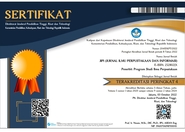Tanda Tangan Digital: Otoritas pada Arsip Elektronik
Abstract
The Covid19 pandemic has triggered more massive and extensive use of electronic records due to the Work from Home policy. One of the keys in using electronic records is a digital signature as an authorization stamp for the electronic record. The concept of authentic digital signature and integrity is still unfamiliar to policymakers, which can lead to legality problems in the future. Digital signatures have three levels of validity from basic, advanced, to high. Not all levels produce electronic records that have legal force, so it is necessary to handle with extra concern to their use of digital signature in institutions or organizations. This writing aims to provide an overview of the concept of a digital signature that is authentic, accountable, and integrity. This writing uses a qualitative method. The result of this writing is that the digital signature must go through encryption and verification so that the digital signature has legal force and what its implementation of digital signature in several countries, including Indonesia.
Keywords
Full Text:
PDFReferences
Almgren, H., & Stengård, M. (2015). How to maintain Authenticity and Integrity of Electronic Information without Utilizing Electronic Certificates. INFUTURE, 441–442. https://doi.org/10.17234/infuture.2015.45
Bhatia, S., & Wright de Hernandez, A. D. (2019). Blockchain Is Already Here. What Does That Mean for Records Management and Archives? Journal of Archival Organization, 16(1), 75–84. https://doi.org/10.1080/15332748.2019.1655614
Connective. (2019). Three types of Electronic Signatures and how to choose the right type for your transactions. Retrieved February 1, 2020, from https://connective.eu/three-types-of-electronic-signatures/
Drescher, D. (2017). Blockchain Basics: A Non-Technical Introduction in 25 Steps. Apress.
Dumortier, J., & Eynde, S. Van Den. (2002). Electronic Signatures and Trusted Archival Services. DLMForum 2002, (July), 520–524. https://doi.org/10.1.1.122.1484
Duranti, L., & Rogers, C. (2012). Trust in digital records: An increasingly cloudy legal area. Computer Law and Security Review, 28(5), 522–531. https://doi.org/10.1016/j.clsr.2012.07.009
Privy. (2018). Kenali 3 Jenis Tanda Tangan Digital. Retrieved February 10, 2020, from https://blog.privy.id/3-jenis-tanda-tangan-digital/
Ustundag, A., & Cevikcan, E. (2018). Industry 4.0: Managing The Digital Transformation. (D. T. Pham, Ed.). Cham: Springer. https://doi.org/10.1007/978-3-319-57870-5
Whitman, M. E., & Mattord, H. J. (2016). Principles of Information Security (5th ed.). Cengage Learning. https://doi.org/10.1016/b978-0-12-381972-7.00002-6
DOI: http://dx.doi.org/10.30829/jipi.v6i1.8165
Refbacks
- There are currently no refbacks.
Copyright (c) 2021 Muhammad Usman Noor

This work is licensed under a Creative Commons Attribution-ShareAlike 4.0 International License.










_1.png)
.png)
_.png)

